
An island with a natural sense of “differentness” from neighboring places and, during its “Golden Age” (6th to 9th centuries CE), the most advanced culture in Europe, Ireland has quite a few distinctive, ancient architectural features that are only rarely seen outside the country. Here is a selection of those we’ll see examples of on our tour.
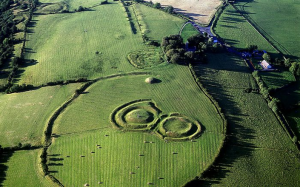
Earthworks
Ireland’s numerous earthworks, like those at the Hill of Tara, give the landscape an eerie, pock-marked quality and are best seen from above. They remain somewhat mysterious, as most have never been excavated. These mounds of carefully shaped dirt, sometimes packed with stone, are believed to have been built during the Stone Age (6000-2000 BC), but they were reused, rebuilt, and reinterpreted by subsequent generations, including modern day so-called “druids.” Fortresses, burial or ceremonial sites, enclosures for animals, palaces—they served many purposes over the centuries.
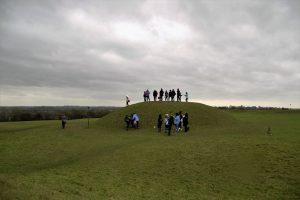
Quite a few of the earthworks are associated with the myths and legends brought by invading peoples long after their construction. The Hill of Tara is the most famous of these, with its many mounds and furrows and stunning views of the surrounding countryside. The site figures in myth as a center of power and sacredness and continued to have such significance through the centuries. Tara’s mythological fame meant that Irish kings or clan heads wanted to be crowned there. When St. Patrick returned to Ireland to convert the pagans in the fifth century, he came to Tara. In the nineteenth century, the “Great Liberator” Daniel O’Connell held “monster meetings” at Tara, rallying Catholics to force Britain to repeal the Penal Laws that had been intended to stamp out their religion, thus eliminating them as a political threat. Cuchullain, the heroic boy-god associated with the rebels of 1916, is said to have lived at one of the most massive earthworks at Eamhain Mhacha (OW-en MAH-kah) or Navan Fort in County Armagh.
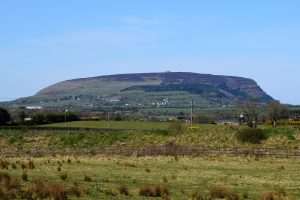
We’ll see the famous stand-alone mountain Knocknarea near Sligo: the earthwork or mound on top is supposed to be the tomb of Queen Maeve. The fairy people were thought to live underground in these structures; they were called “aos sí ” or “people of the mounds” (“sí” is the word for mounds), which was eventually shortened to “sidhe” (SHEE). You know this word in another word, “banshee,” which means “woman (ban) fairy (shee).” The sidhe are not adorable, tiny, Tinkerbell-like fairies, by the way, but a powerful and often malevolent race of life-sized or even larger people, a race that was banished underground long ago and continues to bother and seek vengeance on the usurpers of their land. Like the megalithic tombs mentioned below, the earthworks in Ireland still have a connection to the supernatural for some, as evidenced by the “rag trees” nearby–trees bedecked with scraps of clothing left in commemoration of the dead or supplication for the living. The earthworks building sites are thought to be “thin places” where the passageway between the earthly and the supernatural is notably fluid.
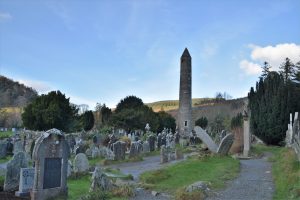
Round Towers
Built by monks from the 9th to the 12th centuries CE, these remarkable structures are distinctly Irish: there are only three outside the country, two in Scotland and one on the Isle of Man. They range in height from 59 feet to 130 feet and show sophisticated engineering for their times. Each one has a door seemingly elevated from the ground, but some scholars think these doors were once at ground level. Other common features are windows at the top facing four directions and a conical rooftop.
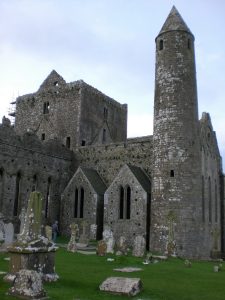
Used as bell towers to summon the monks for prayer and as lookouts, the towers were an integral part of daily life in the monastic community. The theory that they were used by the monks to hide their treasures and themselves from marauding Vikings has been discounted. After all, the wooden doors could easily have been set afire, and the tall, hollow towers would have made excellent chimneys. There were once at least 120 of these towers in Ireland: most are in ruins today, but about 20 remain in good condition. We’ll see a fine one at the Rock of Cashel, a partial tower at Drumcliff in Sligo, and others along the way.
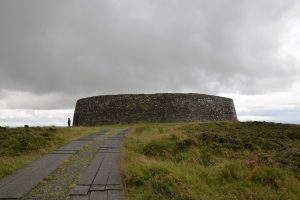
Ringforts
Found in Wales and Cornwall but very numerous in Ireland, ringforts were circular stone or stone and earth structures with open courtyards. There is a lot of debate about when they were built, but recent theories suggest the early middle ages, probably between 500 and 1000 CE. Some researchers believe there were once as many as 50,000 of these fortifications in Ireland, each the domain of a family or clan. Defensive in nature, ringforts also seem to have been used for different purposes in different places. Some housed farm animals and small dwellings, others were used for manufacturing pottery, still others may have been the dwellings of royalty or places of ceremony. Weather permitting in County Donegal near Derry, we will be able to see one of the most famous of these, Grianán of Aileach, positioned on hill with stunning views of the surrounding countryside. Like many ringforts, this one was probably a place of varying significance for different generations and may have been built on a much more ancient site. The fort plays an important role in Seamus Deane’s novel Reading in the Dark.
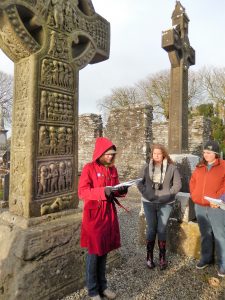
High Crosses
Large standing crosses elaborately carved with bible stories and symbols are found all over Ireland and Britain, with a few in Scandinavia. Dating mostly from the 9th century CE, the crosses in Ireland are the most richly decorated and usually consist of a cross and a ring together: crosses of this type are called “Celtic crosses,” the ring thought by some to be a strengthening feature and by others to reference the sun god of the “Celtic” pagans whom the Christian missionaries like St. Kevin and St. Patrick sought to convert. I put “Celtic” in quotation marks because recent DNA studies and other research are dramatically challenging the received wisdom about the peoples typically referred to by this name.

Many of the high crosses were destroyed or damaged during the Reformation, and today they are falling victim to weather and air pollution. Some have been replaced by replicas and are housed indoors for protection. High crosses are thought to have been used as biblical teaching tools by monks, as the panels typically represent a standard selection of new and old testament stories such as Adam and Eve, David and Goliath, Cain slaying Abel, the adoration of the magi, the resurrection, etc. They also feature unique carvings probably representing the artist, such as the cats at the bottom of Muirdeach’s Cross at Monasterboice.
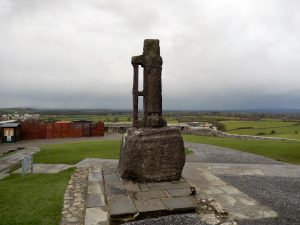
We’ll see an unusual type of high cross called a Latin Cross at the Rock of Cashel and a more typical carved high cross at Drumcliff. The crosses are scattered across the island, and my husband and I are on a mission to see all of them; so far we’ve visited about two thirds.
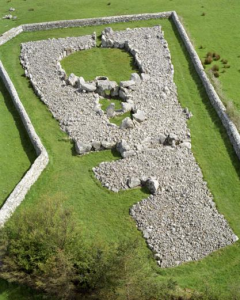
Court Tombs
There are many types of megalithic tombs in Ireland, structures that were reused and reinterpreted by subsequent generations like the earthworks mentioned above and often associated—even today—with the fairies. We’ll visit one of these when we drive north from Sligo, a place called “Creevykeel.” Probably built somewhere between 4000 and 25000 BCE, Creevykeel has an oval courtyard leading to two further enclosed areas housing burial chambers.
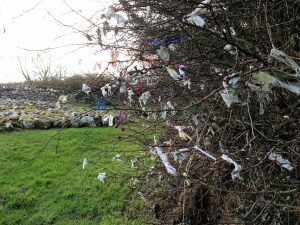
The elements along with tourists and vandals have damaged Creevykeel and most of the other megalithic tombs, so little is known about them except that the cremated remains of a small number of people—Royalty? Heroes? Priests? Particular clans?—were kept in their innermost chambers, and the efforts of more than one generation of workers went into constructing the tombs, often with large rocks that came from many miles away. Strong beliefs must have motivated such effort. Several rag trees on the path between the parking area and the tomb show that Creevykeel is very much an active place for spiritual communion today.
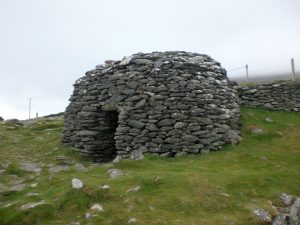
Beehive Huts
Beehive huts or “clocháin” (clawk-AWN) in Irish are dry-stone constructions with corbelled roofs that are usually associated with monastic settlements. They seem to have been built over a very long period from the neolithic era to modern times, mostly in southwestern Ireland. The smaller ones may have been used as places of hermitage, and they do seem to have had a religious purpose. We’ll see a group of them at Fahan on the Dingle Peninsulas that are thought to be 12th century. There is another famous collection on Skellig Michael, the rocky island off the Kerry coast recently in the news because the last scene of Star Wars: Episode VII The Force Awakens was filmed there. Click on the green text to see a short video about the movie in which the beehive huts figure prominently. Visiting the Skellig is all all day trip, but we’ll be able to see it from the Dingle Peninsula, weather permitting. Gallarus Oratory, also on our tour of the Dingle Peninsula, is a larger version, which some believe to have served as a church.
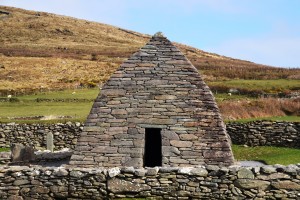

I was hopng for a post today; thank you for this great one. And I always thought the shee in banshee was the female part!